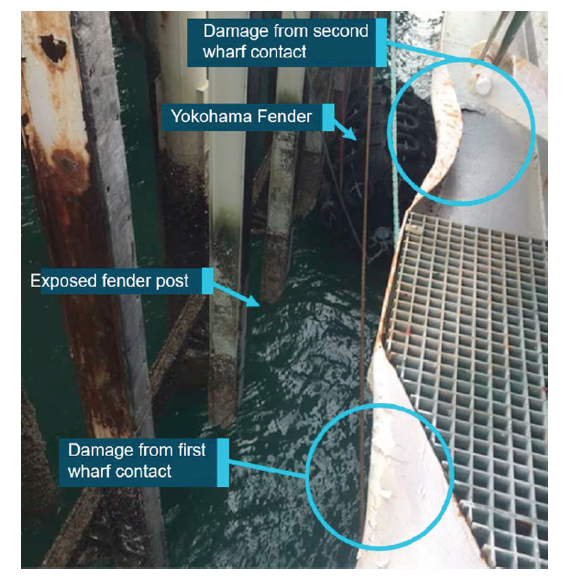201962 Dock fenders rendered ineffective by low tide
Edited from official ATSB (Australia) report 343-MO-2018-006
A livestock carrier was inbound to load cattle. The bridge team consisted of a pilot, the Master, chief mate and a seaman at the helm.
The Master-Pilot exchange (MPX) discussed the berthing plan, with particular attention to the fact that the vessel’s bow thruster was inoperable and only one harbour tug was available. Although the port handbook recommended that ships the length of the livestock carrier (and those with no bowthruster) utilise two tugs for manoeuvres, the pilot explained that he had already discussed the issue with the Harbour Master. They had concluded that berthing with a single tug was possible in light winds if completed within an hour of slack water.
The pilot explained the plan to the ship’s chief mate and Master, and they agreed with the manoeuvre. The ship came alongside the wharf, with two Yokohama fenders positioned forward and aft between the ship and wharf’s vertical fender posts. It was now low water (1.55 m).
The ship was about eight metres aft of its berthing position when mooring lines were run to the wharf. The pilot then tried to use the mooring winches and lines to move the ship forward into position. He also instructed the tug, in position about amidships, to push forwards at a 45° angle using minimum power to assist in the repositioning.
The weight of the ship forced the forward Yokohama fender under the fender posts, which resulted in the ship’s bow moving towards the wharf. Shortly after, an overhanging scupper protrusion made contact with the fender post.
The pilot thought that the ship had pivoted on the Yokohama fender and instructed the tug to stop pushing. The ship moved slightly off the fender posts and the fender cleared the post. About two minutes later, the pilot instructed the tug to push minimum forward again, resulting in the forward Yokohama fender once again passing underneath the fender posts. The ship’s bow again moved towards the wharf, and the scupper protrusion again made contact with the fender post. The pilot instructed the tug to stop, and the ship came away from the vertical fender posts. The pilot then advised the Master to use the ship’s engines to reposition the ship, which was done without incident. Post-incident investigations by the Port Authority and the pilotage provider confirmed that the fender posts at this berth were shorter than at others.
There was no evidence that these shorter posts or the potential for fenders to be forced under them at low water levels had been documented or shared with pilots through training or instruction.

The official investigation found that:
- The height of tide when the vessel was berthing was low enough to expose the base of the wharf’s fender posts. When the forward Yokohama fender came under pressure it was forced under the post, which allowed contact with the post and damage to the ship.
- The harbour master and pilot were unaware of any height of tide limitations associated with berthing ships alongside Yokohama fenders at this berth. Therefore, the risk assessment did not include any mitigating factors for berthing alongside at low water levels.
Lessons learned
- Water level variations can affect how certain port structures interact with vessels.
- As you approach a berth, visually inspect it with binoculars for any anomalies. You may spot them before it is too late.
